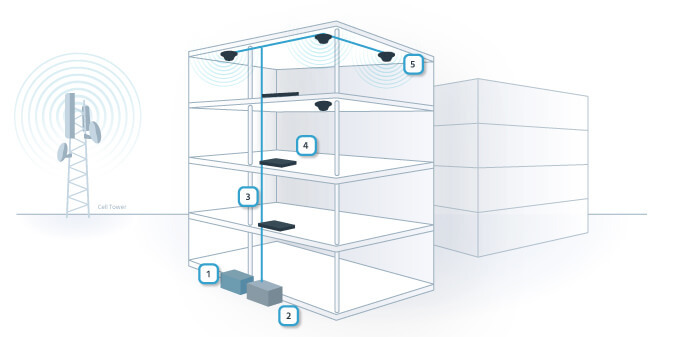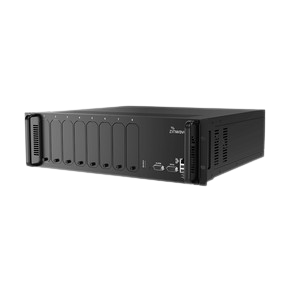Active DAS: A Short Guide
Active Distributed Antenna Systems (DAS) Explained
Distributed antenna systems (DAS) are sophisticated systems used in business enterprises to enhance cellular coverage in areas with poor to no signal. Dropped calls and slow data would be a thing of the past. They can also improve capacity, keeping more people connected.
There are three types of DAS system solutions: Passive DAS, Active DAS, and Hybrid DAS. This blog will focus on all there is to know about Active DAS.
We fix poor cell phone signal! Find the right signal booster for you:




What is an Active DAS?
Compared to Passive and Hybrid DAS, Active DAS is the most powerful cellular boosting solution available. It connects directly to your desired cellular providers. Thus, it can significantly enhance coverage as well as capacity, allowing more devices to connect without experiencing service drops. Active components, meaning they require a power source, are used for this setup to handle, and transmit a strong signal.
What is the Topology of an Active DAS?

There are five main parts to most Active Distributed Antenna Systems:
- Signal Source: Feeds radio frequency (RF) signals to Master Unit.
- Master Unit: Converts RF signals received from the signal source to digital.
- Fiber or Ethernet Cabling: Transmits signal from Master Unit to Remote Unit with minimal loss.
- Remote Units: Convert digital signals back to RF signals.
- Antennas: Broadcast RF signals throughout.
Scalable, Active DAS can cover virtually any size building. However, due to cost, it is best suited for buildings over 500,000 sq ft.
How Do Active DAS Work?
An Active DAS receives cellular signals directly from one or multiple cellular providers via carrier-specific base transceiver stations (BTSs) or small cells. A BTS is most common as it allows more capacity. Carrier approvals are required to get a BTS from your desired carriers. This can take a minimum of 6 months. Small cells don't require carrier approval, though they have capacity limitations.
BTSs or small cells connect to a Master Unit, which converts received RF signals from desired carriers to digital for transmission across fiber or ethernet cabling. These types of cables facilitate significantly less signal loss across long runs than coaxial cable, making Active DAS a great solution for large buildings and campuses. If a building is already prewired with fiber or ethernet, existing infrastructure can be used for installation, reducing cost and turnaround time. Custom cabling will be needed for non-prewired buildings.
Remote units (RUs), also known as remote nodes, located throughout the building receive the digital signals, convert them back to RF, and transmit them to connected antennas for broadcasting. Since the signal is coming directly from the carrier, provided coverage is significantly better than that of a Passive or Hybrid DAS. End-users will receive a stronger and crisper signal for all their cellular connectivity needs.
Zinwave offers the most innovative Active DAS.
What is the Best Active DAS Solution Available?
Zinwave has developed a future-proof, wideband, fiber-based DAS solution. It consists of 5 components:
- Service Modules: interface with the RF signal source (i.e. BTS or small cell).
- Primary Hub: Receives RF signals, converts signals to optical, and directs them.
- Optical Modules: Enable fiber connection from primary hub to secondary hub or remote unit.
- Secondary Hubs: Add coverage and extend the reach of the system.
- Remote Units: Convert optical signals to RF and amplify them for users.
A single layer of hardware supports 2G, 3G, 4G, and 5G as well as public safety, and other private radio networks. When used with a BTS or small cell, it makes for an unmatched Active DAS solution.
At the point of installation, the system can be customized to your business's network needs. The primary hub's unique modular design allows the integration of additional carriers and technologies post-installation without needing to adjust or replace hardware, making it more cost-effective than other Active DAS systems on the market. By using fiber optic cable throughout, Zinwave’s Active DAS enables longer cable runs with lower loss and more bandwidth than with ethernet, allowing a single system to power a whole campus.

There are two Zinwave Active DAS solutions to choose from:
- Uniwave 8000 - Supports frequencies from 150 MHz to 5 GHz. If looking to cover your building with 5G now or in the future, Uniwave is the way to go. While it may not support the ultra-fast mmWave, it does work with mid-band 5G which includes C-Band and low-band 5G. Remote units for this system are available in SISO, MIMO, and 4X4 MIMO configurations.
- Unitivity 5000 - Supports frequencies from 150 MHz to 2.7 GHz. This system has been leading the way in DAS for over 10 years. It can blanket buildings with low-band 5G, 4G, LTE, and other networks. Remote units are only available in SISO configurations.
Our professional Active DAS installation team will help you every step of the way – from listening to your needs to designing a system to installation.

Interested in Zinwave Active DAS? Contact us at 1-800-887-1961 for more information.
What Are the Advantages and Disadvantages of a Zinwave Active DAS?
Advantages:
- Supports any network operating on frequencies 150 MHz to 5 GHz (depending on model)
- Unmatched coverage and capacity
- Scalable to the size of a campus or building
- Future-proof to accommodate growing demand or additional carriers
- Fiber-based eliminates cable length constraints
- More cost-effective than other Active DAS solutions available
Disadvantages:
- Requires carrier approval if using BTS
- Lengthy deployment time
- More expensive than Passive or Hybrid DAS
Where Can a Zinwave Active DAS Be Used?
A Zinwave Active DAS can be installed in any building or campus across any industry, including but not limited to:
- Healthcare
- Education
- Hospitality
- Retail
- Airport
- Commercial Real Estate
- Public Safety
Active DAS systems can be designed to fit any building size. Though, we typically recommend an Active DAS for buildings over 500,000 sq ft.
Contact Us to Supercharge Your Business with Zinwave Active DAS
Zinwave has the Active DAS solution for your problem. It's the only Active DAS on the market today covering the entire radio spectrum, from 150 MHz to 5 GHz, in a single layer of hardware. That means 5G, public safety, and even good old-fashioned ham radio. Whatever your needs are, Zinwave equipment will meet them at a fraction of the cost of other providers. Wilson Amplifiers and its partners, the Bolton Install Pro team, have the expertise to design and install it.
We'll bring high-quality Active DAS to you via five easy steps:
- Listening to Your Needs
- Surveying Your Site
- Obtain Necessary Approvals
- Designing Your Solution
- Complete Turnkey Installation
Call us at 1-800-887-1961 or email us at sales@wilsonamplifiers.com for a free consultation.
Further DAS Readings:
Interested in Learning More? Check Out Our Signal Boosting Info Center


Money Back Guarantee

Technical Support